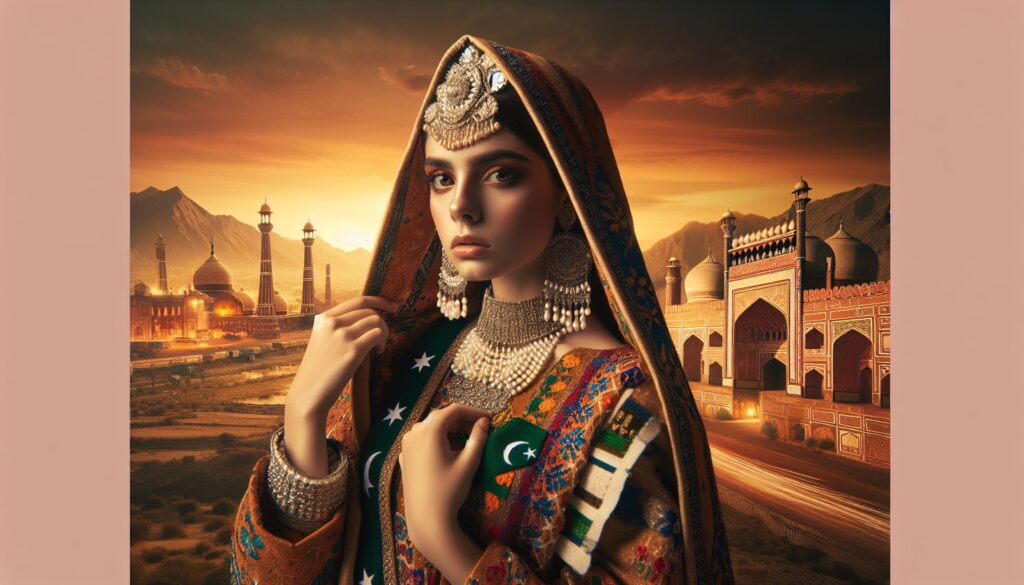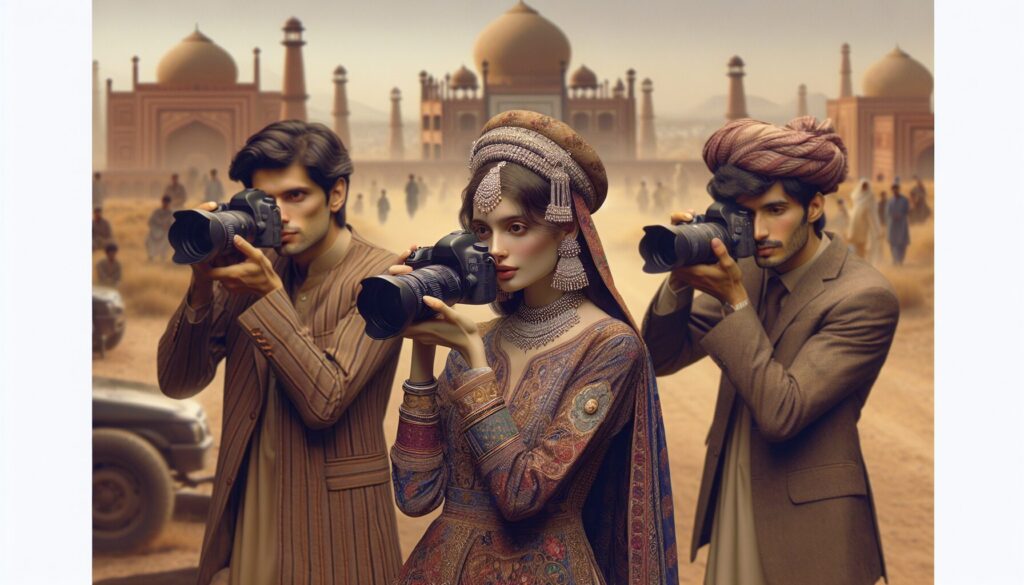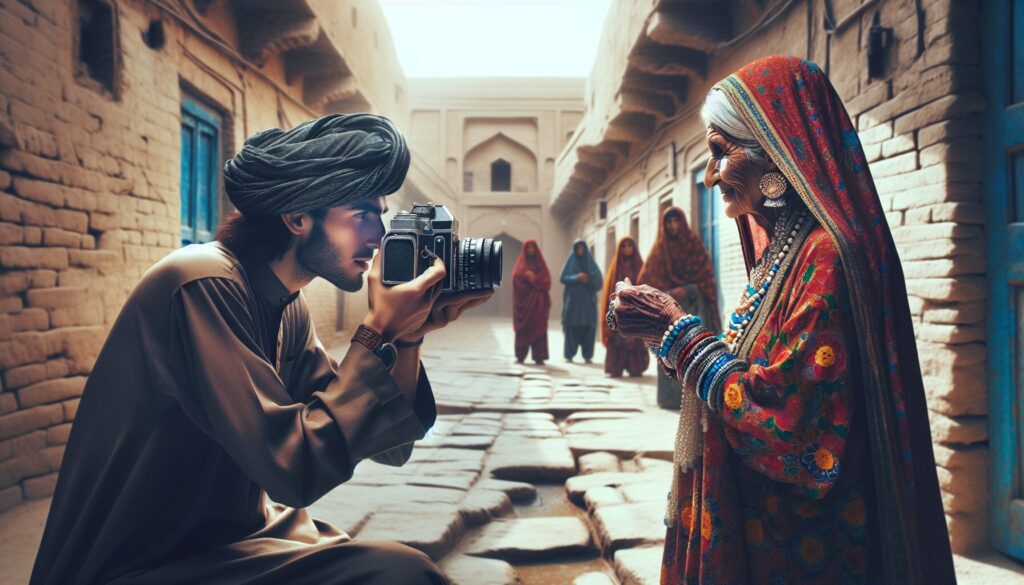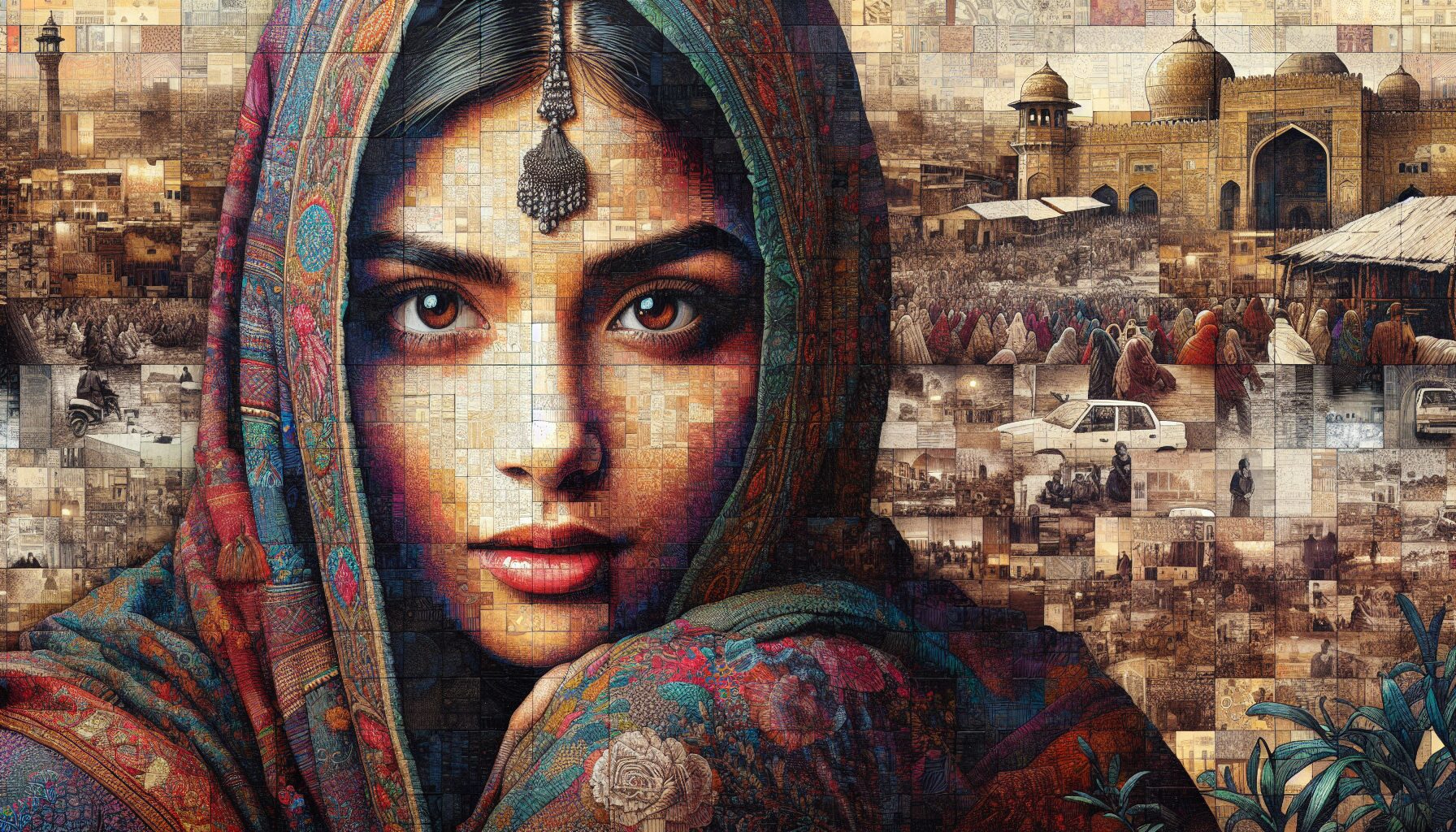Portrait photography in Pakistan is truly a vibrant tapestry of tradition and modernity, capturing the essence of its diverse cultures. I remember my first shoot in Lahore with my trusty Canon EOS R5. I paired it with a 50mm f/1.8 lens, which is perfect for portraits. The 50mm lens allowed me to capture stunning bokeh, making my subjects pop against the backdrop of the bustling streets. I set my camera to ISO 100, f/2.8, and a shutter speed of 1/250s to capture the perfect light and detail. Pakistan offers a rich palette for photographers. From the colorful bazaars to the serene landscapes, each portrait tells a story. The cultural expressions in Pakistan are endless, from the traditional attire of the Kalash people to the vibrant truck art seen across the country. It’s like walking through a living gallery, where every face holds a unique story. The diversity is breathtaking, and each region has its unique charm. My trips often take me to places like Lahore Fort or Badshahi Mosque, where history and culture merge beautifully. Each photograph becomes a portal into a world of rich heritage and storytelling.
Historical Context and Evolution of Portrait Photography
Portrait photography in Pakistan has a rich and fascinating history that reflects the vibrant cultural expressions of its people. Imagine the early days, when photographers used large-format cameras like the Graflex Speed Graphic. These cameras were quite a sight, with their bellows and large glass plates. Photographers had to be patient, waiting for just the right moment to capture a person’s essence. It wasn’t just about taking a picture; it was about telling a story.
Fast forward a bit, and you’ll find the emergence of film cameras like the Nikon FM2. This camera was a favorite among professional photographers in the 1980s and early ’90s. Its durability made it perfect for the bustling streets of Lahore or the serene landscapes of Hunza. Photographers used prime lenses, like the 50mm f/1.8, which offered a beautiful depth of field, isolating the subject against a softly blurred background. This technique highlighted the person’s features, creating portraits that seemed almost alive.
As technology evolved, digital cameras changed the scene dramatically. The Canon EOS 5D Mark III, for instance, became incredibly popular. Its full-frame sensor allowed photographers to capture stunning detail, even in low light. This was a game-changer for capturing the vibrant colors of traditional Pakistani attire during weddings or the subtle expressions of elders during Eid celebrations. Photographers could experiment with settings like ISO 100, f/16, and 1/30s to achieve the perfect exposure.
Modern Techniques and Styles
Today, portrait photography in Pakistan continues to evolve with the use of mirrorless cameras such as the Sony A7 III. These cameras are lightweight and versatile, making them ideal for on-the-go shoots. Photographers often use advanced techniques like high-speed sync flash to freeze motion and create dynamic portraits in bustling city markets or serene rural settings.
- Use of polarizing filters to reduce glare and enhance colors.
- Experimenting with HDR (High Dynamic Range) photography to capture the full range of tones in a scene.
- Incorporating off-camera flash for creative lighting effects.
Influential photographers like Tapu Javeri have played a significant role in shaping the portrait photography scene in Pakistan. Their work showcases the diversity and depth of cultural expressions across the country. From the vibrant streets of Karachi to the majestic mountains of the north, each portrait tells a unique story, capturing the essence of Pakistan’s rich heritage.
Influence of Pakistani Culture on Portrait Styles

There’s something truly magical about capturing the essence of Pakistani culture through portrait photography. Every image tells a story, influenced by the rich tapestry of traditions, colors, and emotions that define this beautiful country. As a photographer, I’ve always been fascinated by how the culture impacts portrait styles, creating unique and vibrant expressions.
One of my favorite experiences was shooting in Lahore. Using my trusty Canon EOS R5 paired with a 50mm f/1.8 lens, I aimed to capture the essence of Lahore’s bustling streets. The f/1.8 aperture was perfect for creating a dreamy bokeh effect, isolating the subject against the vibrant backdrop of Anarkali Bazaar. The bustling market, filled with colorful fabrics and intricate jewelry, inspired me to focus on the details. This approach highlighted the traditional attire and the intricate henna designs, each telling a part of the larger cultural narrative.
Traditional Attire as a Portrait Feature
Pakistani traditional attire often plays a central role in portrait photography. The vivid colors and intricate patterns of shalwar kameez and sarees provide photographers with a visual feast. When shooting, I often use a tripod and set my camera to ISO 100 with f/16 to capture these details sharply. This setting ensures every thread and bead is visible, adding depth and authenticity to the portraits. The cultural significance of these garments is profound, representing not just style but identity and heritage.
The Influence of Festivals and Celebrations
Festivals like Eid and Basant are vibrant occasions that influence portrait photography styles significantly. During Basant, Lahore’s sky fills with colorful kites, offering a stunning backdrop for portraits. Using a polarizing filter during these events enhances colors and reduces glare, making the images pop even more. A fast shutter speed of 1/1000s helps capture the excitement and movement, especially when children and adults engage in kite flying.
- Colorful Backdrops: Utilize the natural vibrancy of festivals to enhance your portraits.
- Dynamic Poses: Capture the energy and joy of celebratory dances and activities.
Religious and cultural expressions are deeply woven into the fabric of Pakistani life. Portraits taken in mosques or during religious ceremonies often convey a sense of tranquility and devotion. I once photographed at the Badshahi Mosque, using a wide-angle lens to capture the majestic architecture. This not only framed the subject beautifully but also emphasized the grandeur of the mosque.
According to National Geographic, cultural expressions in photography help preserve traditions and promote understanding across different societies. This underscores the importance of incorporating cultural elements into our work. For more insights on capturing such cultural heritage, check out your natural keyword-rich anchor text here.
From the vibrant streets of Karachi to the serene landscapes of Hunza, the influence of Pakistani culture on portrait styles is both profound and inspiring. Each region offers its own unique flavor, blending tradition with modernity in a way that’s visually captivating and deeply meaningful.
Renowned Portrait Photographers in Pakistan

Let’s dive into the world of portrait photography in Pakistan, where a handful of photographers have truly made their mark. One of my favorites is Tapu Javeri, whose work is a blend of fashion and portrait photography. He often uses a Canon EOS R5, paired with a 50mm f/1.8 lens, to capture stunning portraits. His attention to detail and use of natural light make his portraits come alive. I remember trying out his technique of shooting during the golden hour. It was a game-changer for me, adding warmth and depth to my portraits.
Ayesha Malik
Another name that stands out is Ayesha Malik, an incredible portrait photographer known for her vibrant and expressive images. She loves to experiment with different settings, often using a Nikon D850 with a 85mm f/1.4 lens. I once attended a workshop where she explained her process of engaging with her subjects. Her tip on using an ISO of around 400 in indoor settings to maintain image quality was invaluable. It was amazing to see how she brought out the personality of her subjects with simple yet effective techniques.
Bilal Javaid
Bilal Javaid is another photographer whose work I admire. He specializes in capturing the rich cultural tapestry of Pakistan through his portraits. Bilal often uses a Canon EOS-1D X Mark III, which is perfect for low-light conditions. His technique of using a polarizing filter to enhance colors and reduce reflections is something I’ve adopted in my own work. It’s fascinating to watch him work, his ability to capture candid moments with precision is truly inspiring.
Common Techniques
Many renowned photographers in Pakistan employ specific techniques to enhance their work:
- Golden hour shooting for soft and flattering light.
- Use of prime lenses, like the 50mm or 85mm, for sharp portraits.
- Engagement with subjects to capture authentic expressions.
- Experimentation with ISO settings to handle different lighting conditions.
These photographers, with their unique styles and techniques, offer a window into the diverse cultural expressions of Pakistan. Each one brings a personal touch to their portraits, making their work not just photography but a piece of art.
Techniques and Tips for Capturing Cultural Expressions

Exploring the vibrant tapestry of cultural expressions through portrait photography in Pakistan is such a rewarding experience. Each region, from the bustling streets of Karachi to the serene valleys of Swat, offers unique stories and emotions to capture. When I first picked up my trusty Canon EOS R5 with a 50mm f/1.8 lens, I knew I was in for an adventure. The journey of capturing cultural essence isn’t just about snapping photos but understanding the nuances and techniques that bring these expressions to life.
Understanding the Environment
Before diving into the technicalities, it’s essential to get a feel of your surroundings. This involves engaging with the locals and understanding their way of life. In Lahore, for instance, the vibrant energy of Anarkali Bazaar offers a plethora of opportunities. Using natural light is crucial here. I often set my camera to ISO 100 to minimize noise, keeping the aperture around f/4 to ensure sharpness and depth. This results in beautifully detailed portraits that highlight the subject’s expressions against the lively backdrop.
Mastering Lighting Techniques
Lighting can make or break a portrait. In the bustling streets of Peshawar, where the golden hour casts a warm glow, I love utilizing backlighting. This technique involves placing the light source behind your subject, creating a halo effect. It adds a magical touch to the portraits. Adjust your settings to f/16 and 1/30s to balance exposure and maintain clarity. Don’t forget to use a reflector if needed, ensuring the subject’s face is well-lit while preserving the natural ambiance.
Engaging with Your Subjects
Building rapport with your subjects is just as important as the technical aspects. In the northern areas, like Gilgit-Baltistan, people are often shy but incredibly hospitable. A warm smile and a simple greeting in their local language can work wonders. Once they’re comfortable, their natural expressions shine through, allowing you to capture genuine moments. This approach is crucial for portraying the rich cultural heritage authentically.
Technical Tips and Tricks
- Use a polarizing filter to manage reflections and enhance colors, especially during midday shoots.
- Experiment with different perspectives. A low angle can add grandeur to the subject, while a higher vantage point offers a distinctive view.
- Consider using a wide-angle lens for group portraits. This captures more of the cultural context surrounding your subjects.
While wandering through the historical streets of Multan, I once had the chance to capture the intricate tile work that adorned a local shrine. By adjusting my Canon EOS R5 to ISO 200 and using a 24-70mm lens, I could emphasize both the subject and the vibrant background. This technique is perfect for showcasing the region’s artistic heritage. For more on how to capture the essence of Pakistan’s cultural heritage, check out this detailed guide.
The Role of Portrait Photography in Cultural Preservation
Portrait photography in Pakistan is like a vibrant tapestry, weaving together the threads of history, tradition, and personal stories. It plays a crucial role in preserving the rich and diverse cultural heritage of this beautiful land. Imagine capturing the essence of a lively bazaar, where the air is filled with the aroma of spices and the vibrant colors of traditional attire. A well-timed portrait can encapsulate these moments, preserving them for generations to come.
Once, I was wandering through the streets of Lahore with my trusty Canon EOS R5 slung around my neck. The challenge was to capture the soul of the city through its people. I had my 50mm f/1.8 lens attached, perfect for focusing on the intricate details of traditional attire and expressions. The settings were crucial; ISO 100, f/2.8, and a shutter speed of 1/125s allowed me to get sharp images with a beautiful background blur, highlighting the subject against the bustling cityscape. Each click of the shutter was a step into the living history around me.
The Importance of Traditional Dress in Portraits
Portrait photography in Pakistan often highlights traditional dress, a vital element of cultural preservation. The elaborate embroidery, vibrant colors, and unique styles of shalwar kameez or lehengas tell stories of regional identities. Each region, from Sindh to Gilgit-Baltistan, boasts distinct attire. These clothes are not mere garments; they are cultural symbols, captured beautifully through the lens.
- Shalwar Kameez: This versatile outfit is worn by both men and women across Pakistan. Its comfort and style are unmatched.
- Ajrak: A specialty of Sindh, this unique block-printed shawl is a symbol of pride and tradition.
- Chitrali Cap: Commonly worn in the northern regions, this cap is a cultural icon in itself.
During a visit to a small village in Punjab, I was invited to a local wedding. My Nikon D850 with a 24-70mm f/2.8 lens was the perfect companion. The low light conditions of the event hall required a fast lens. I adjusted my settings to ISO 1600, f/2.8, and 1/60s shutter speed. The images captured the bride adorned in exquisite jewelry, each piece telling a story of heritage and familial ties. Portraits from such events are more than just photographs; they’re timeless records of cultural legacies.
Portrait photographers in Pakistan also use advanced techniques to enhance their work. For instance, a polarizing filter can reduce glare and enhance colors, making the vibrant hues of traditional clothes pop even more. The role of portrait photography in capturing these cultural expressions cannot be understated. It acts as a bridge connecting the past with the present, ensuring that the rich traditions of Pakistan are never forgotten.
Historical sites, like the magnificent Badshahi Mosque or the ancient ruins of Mohenjo-Daro, serve as breathtaking backdrops for portraits. They add layers of depth and context to the images. These sites, steeped in history, amplify the cultural narratives captured within a portrait. The juxtaposition of a modern subject against these timeless structures creates a dialogue between old and new.
In conclusion, portrait photography in Pakistan is more than an art form. It’s a powerful tool for cultural preservation. Through the lens, photographers capture the spirit of a nation, ensuring its stories are shared and celebrated worldwide. Whether it’s the intricate henna designs of a bride or the wisdom in the eyes of an elder, each portrait is a testament to Pakistan’s rich cultural tapestry.
Conclusion
Portrait photography in Pakistan is a vibrant journey through diverse cultural landscapes. It’s a tapestry woven with stories, emotions, and rich traditions. I remember one session in Lahore with a Canon EOS R5. I paired it with a 50mm f/1.8 lens. The soft light just after dawn, with settings like ISO 100 and f/16, captured the intricate details of a traditional shalwar kameez. Each stitch seemed to tell a story.
In Karachi, the bustling streets offer a different vibe. I once captured a candid moment using a 24-70mm f/2.8 lens. It was perfect for the fast-paced environment. The city’s vibrant backdrop highlighted the subject’s expressions beautifully. Adjusting the shutter speed to 1/500s ensured sharp, clear images even amidst the chaos. The experience was exhilarating, almost like a dance with the city’s heartbeat.
Venturing into the northern areas, like Hunza, the natural light is a game-changer. Using a polarizing filter with a wide-angle lens can enhance the stunning landscapes. I remember setting my camera to ISO 200 and f/11. The results were breathtaking. The interplay of light and shadow against traditional attire was mesmerizing. It felt like capturing the essence of Pakistan’s cultural diversity.
Each region, from the vibrant streets of Karachi to the serene valleys of Hunza, offers unique opportunities. Portrait photography here is not just about images; it’s about connecting with the heart and soul of the people. It’s about celebrating the colors, textures, and expressions that define this beautiful land.
Continue Exploring
Unlock the secrets of Pakistan's rich cultural tapestry in a visual journey that captures its essence through the lens. Dive into a comprehensive guide that will transform your photography skills and deepen your appreciation for this vibrant heritage.
Frequently Asked Questions
What are the unique cultural influences on portrait photography in Pakistan?
Portrait photography in Pakistan is deeply influenced by the country’s rich cultural tapestry, which includes a blend of Islamic, Persian, and South Asian traditions. Photographers often incorporate traditional attire, vibrant colors, and historical settings to reflect the diverse ethnic and cultural backgrounds present in Pakistan. These elements help capture the essence of Pakistani identity and heritage in their portraits.
How does portrait photography capture the diversity of Pakistani ethnic groups?
Portrait photography in Pakistan captures the diversity of its ethnic groups by highlighting distinct cultural attire, facial features, and traditional practices unique to each group. Photographers often travel to different regions to document the variety of lifestyles and traditions, showcasing the beauty of groups such as Punjabis, Sindhis, Baloch, and Pashtuns, among others. This approach not only celebrates diversity but also fosters a deeper understanding of the nation’s multicultural fabric.
What are some popular locations for portrait photography in Pakistan to showcase cultural expressions?
Pakistan offers numerous picturesque locations for portrait photography that highlight cultural expressions. Historical sites such as Lahore Fort, Badshahi Mosque, and Mohenjo-daro provide dramatic backdrops steeped in history. Additionally, the vibrant streets of Karachi and Lahore, as well as the serene landscapes of Hunza Valley and Skardu, offer diverse settings that capture the essence of Pakistani culture and its people.


Leave a Reply